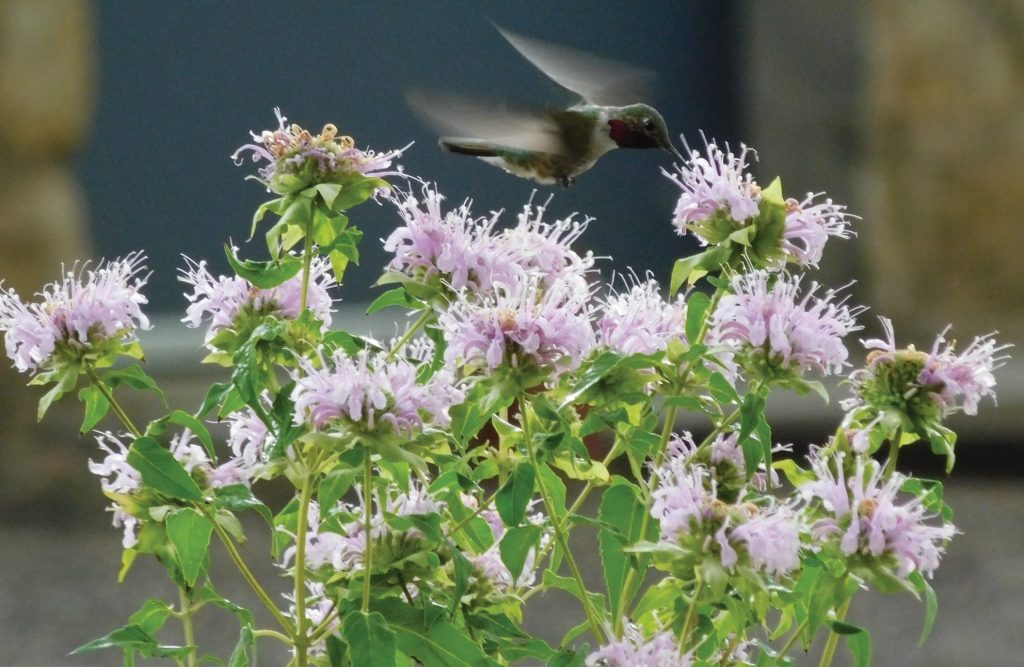
When it comes to summer bird feeding in Colorado, experienced and novice birders alike can learn a thing or two from Denver Audubon’s community outreach coordinator, Kate Hogan. With a background in exotic wildlife and years of experience educating the public about the ecosystems that all life depends on—locals have heeded her tutelage through the Lone Tree Arts Center, High Line Canal Conservancy and more—Hogan has a special place in her heart for protecting the region’s native birds. “There is so much work to be done in terms of wildlife conservation—particularly with bird populations along the Front Range,” she says. “Time is of the essence, so educating people and giving them the tools to cultivate wild bird habitats in their backyards has a big positive impact.”
A core focus in Hogan’s summer classes: There are better (and safer) methods than bird feeders to nourish area bird populations and attract more permanent yard guests. “All wildlife has four basic needs to thrive in a backyard environment: food, water, shelter and space,” Hogan explains. Here are her top tips to create a fowl’s paradise.
USE BIRD FEEDERS SPARINGLY
“It’s completely fine if you want to use a bird feeder in the summer—just be mindful of the ethics of feeding birds with seed during a time when bears are a big problem in Colorado. Set your feeders out for a few hours in the morning and bring them in for the remainder of the day (and especially all night) so you aren’t attracting unwanted predators and pests. You’ll also need to disinfect and refill feeders with fresh seed regularly; feeders are one of the main ways birds transmit disease to one another. Tube feeders, dish and bottle hummingbird feeders, suet feeders and finch socks are all good to start with. For seed, I’ve had a lot of success with the patio blends that have a variety of small seeds mixed with black oil sunflower seeds and whole sunflower seeds.”
INSTEAD, INCORPORATE NATIVE PLANTS INTO YOUR LANDSCAPE
“During the nesting season [April through August], over 96 percent of terrestrial birds switch from a seed diet to an insect and berry diet because it’s high in protein and energy. The key to attracting a more diverse palate of birds is to include native plants that produce berries, encourage insects and provide natural sources for seed. I also encourage chemical-free gardening and lawn care because consuming chemicals can be incredibly detrimental to birds.”
AND CREATE SHELTER WITH PLENTY OF SPACE
“Oftentimes the first structures people think of when envisioning shelter for birds are birdhouses, but these man-made lodgings are only attractive to a smaller subset of birds in our region. I advise people to leave a dead or decaying tree on their property because it’s a wonderful way to provide a safe, natural shelter. If you have really dense grasses, shrubs and trees, birds will also build nests there because they feel safe. Just be sure to take into account any potential hazards near shelters—you’ll want to establish habitats away from large windows and keep domestic cats inside.”

GARDEN FEAST
Plants for seed
COMMON SUNFLOWER
(Helianthus annuus)
Attracts sparrows, warblers, finches, vireos, woodpeckers, jays and titmice
COMMON YARROW
(Achillea millefolium)
Attracts chickadees, titmice, orioles, warblers, jays, vireos and thrashers
PRAIRIE CONEFLOWER
(Ratibida columnifera)
Attracts sparrows, finches, grosbeaks, buntings and chickadees
Plants for berries
KINNIKINNICK
(Arctostaphylos uva-ursi)
Attracts hummingbirds, thrushes, wrens, grouse and waxwings
SERVICEBERRY
(Amelanchier alnifolia)
Attracts crows, thrushes, robins and Western tanagers
CHOKECHERRY
(Prunus virginiana)
Attracts over 70 species, including woodpeckers, bluebirds and kingbirds (and bears, so be aware)
Plants for insects
BLACK-EYED SUSAN
(Rudbeckia hirta)
Attracts waxwings, orioles, nuthatches, warblers, wrens, thrushes, jays and chickadees (and monarch butterflies)
GOLDENROD
(Solidago spp.)
Attracts finches, sparrows, buntings and grouse (and monarch butterflies)
GAMBLE OAK
(Quercus gambelli)
Attracts warblers, vireos, towhees, buntings and grosbeaks
Plants for nectar
COLUMBINE
(Aquilegia spp.)
Attracts hummingbirds, orioles, vireos, thrashers, sparrows, warblers and waxwings
INDIAN PAINTBRUSH
(Castilleja)
Attracts hummingbirds, sparrows, orioles and waxwings
BEE BALM
(Monarda)
Attracts hummingbirds, wrens, vireos and woodpeckers
LEARN FROM THE PROS
Denver Audubon
Littleton
303.973.9530


